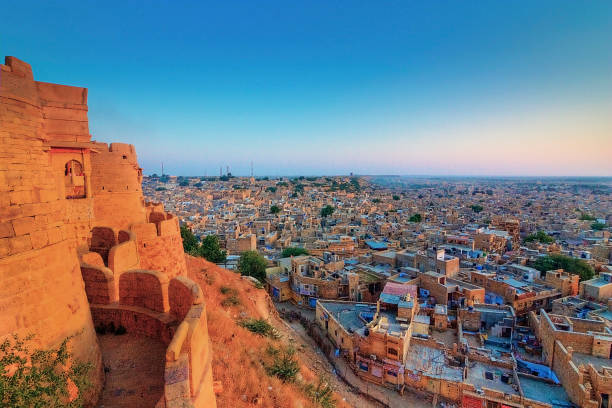Along the north-western edge of India on the border of Pakistan, Rajasthan is often referred to as “the land of kings”. With its opulent palaces, historic forts and plethora of cultural offerings, it wins over hearts at first glance.
Rich in history, Rajasthan mesmerizes all the travelers to her land with its rich and exotic history, which in turn has given the province a rich and varied culture, which is considered to be one of the richest cultures in the world. A tour to Rajasthan is considered to be incomplete without knowledge of the History of Rajasthan, one of the most important aspects of Rajasthan General Info.
Dotted with some of the most exotic havelis and castles imaginable, a trip to Rajasthan in India is made even more memorable by the various stories which are attached to these silent witnesses of an era gone by. Almost each and every monument in Rajasthan has a story linking it to its past that adds an enigma to these otherwise inert blocks of mortar and stone. A history of chivalry, bravery and heroism beckons you to the magical province of Rajasthan the moment you step into this desert paradise.
Fact of Rajasthan
Area: 3, 42,239 Km².
Population: 5, 65, 07,188 (2001 census)
Capital: Jaipur
Language: Hindi, Marwari, Rajasthani.
Ethic Race: Aryan.
Rainfall: 40cm to 110cm. (Avg)
Temperature:
Summer: 25°C to 45°C.
Winter: 10°C to 30°C.
Best Time to Visit: October to March.
Geography
The entire western flank of the State borders with Pakistan, while Punjab, Haryana, Uttar Pradesh and Madhya Pradesh bound Rajasthan in north-east, south-east and Gujarat in south-west.
History
Ancient civilization
Archaeological findings show that the royal land of Rajasthan has been inhabited for several thousand years. To be precise, it can be traced back to the Indus Valley Civilisation. The people of the Harappan times were the first to settle on the embankment of the Sarasvati River that originated in the Aravalli mountain range in Rajasthan. However, the region suffered severe climatic changes and was hit by floods, which led to its abandonment in the aftermath.
For quite some time, it remained without human settlements, until tribal communities, such as the Bhils and Meena, settled in the area. Also, the Aryans were believed to have settled in the area in around 2,000 BC, followed by the Mauryan dynasty during 321-184 BCE. However, due to the strategic location of the state and several ancient rivers, such as the Sarasvati and the Drishadvati flowing through it, the state went on to grab the interest of many empires like Hunas, Arjunyas, Yaudheyas and Saka Satraps, among others
The Gupta dynasty conquered the state in the 4th century and built many Buddhist shrines and caves in the Jhalawar region. In the 6th century, the influence and control of the Guptas started declining. In 700 CE, the Gurjara-Pratiharas took over the Guptas as central power.
Medieval period
In the 9th century, the Rajput dynasty took over the state, the most thriving era in the history of Rajasthan. The Rajputs were warriors and under their rule, the state grew by leaps and bounds. If you stroll along the streets of Rajasthan, you will see majestic historic structures, including forts, palaces and temples built by the Rajput clan. But over the centuries, the Rajput empire was split up into 21 dynasties and 36 royal clans. The unity among them was lost.
In the 10th century, the Chauhans gained control of Rajasthan, but couldn’t reign over it for long. In 1192 CE, the Muslim sultanate defeated Prithviraj Chauhan of the Chauhan dynasty and conquered some parts of the state. Eventually, by 1200 A.D., the Muslim rulers established themselves in many parts of Rajasthan.
In the early 13th century, the most powerful seat was Mewar, which was still under the rule of the Rajputs. Almost every king had their eye on Mewar. It was Mughal emperor, Akbar, who started getting close to many Rajput rulers – he even married a Rajput princess, Jodha Bai, daughter of Amer’s Maharaja. Post-marriage, many Rajput rulers made an alliance with Akbar, which strengthened his control and power over the state. The combination of the Rajput clan and the Mughal empire influence is reflected even today in the historical and architectural landscape of the state.
However, there were some Rajput rulers, like Rao Chandrashekar Rathore (Marwar), Rana Udai Singh (Mewar) and Maharana Pratap (Mewar), who were against Akbar and never bowed down to him. They were in constant war with Akbar. In 1526, a battle between Akbar and Udai Singh took place, in which Akbar took over Chittorgarh, Mewar’s capital. After the defeat, the women of the Rajput clan committed self-immolation in order to protect their honour. Almost the entire Rajputana (now called ‘Rajasthan’) came under the control of Akbar.
In 1576, the Battle of Haldighati between Akbar and Maharana Pratap took place, in which Rana Pratap was severely injured and stayed in recluse for several years. In the meantime, Akbar captured Udaipur, Kumbhalgarh, Chappan, Gogunda and several other regions. Eventually, in 1582 during the Battle of Dewair, Rana Pratap fought back and freed Mewar and much of Rajasthan from the Mughals. This was the era that witnessed the gallantry and sacrifice of several Rajput and Mughal rulers. Some of the most prominent ones include Rana Udai Singh, Prithviraj Chauhan, Maharana Pratap, Rana Kumbha, Rana Sanga and Akbar, to name a few.
The rise of the Maratha Empire and the emergence of the British East India Company
In the early 18th century, the Maratha Empire began gaining power. Under the rule of Peshwa Baji Rao I of Pune, the Maratha Empire expanded to the north of Rajasthan and united with the Rajputs. Most of the Rajput-ruled kingdoms were under the control of the Maratha Empire and continued to flourish. However, the Marathas declined in power with the coming of the British East India Company in the late 18th century. Most Rajput states joined hands with the East India Company, which further resulted in the formation of Rajasthan (then known as ‘Rajputana’) as an independent state. The name ‘Rajasthan’ was popularised by James Tod, an East India Company employee, who was enraptured by the beauty and opulence of the state.
Rajasthan today
The royal state of Rajasthan that we see today was formed in seven stages and became the largest state of the Indian Republic. It has eight UNESCO World Heritage Sites and its magnificent palaces, bustling cities and indigenous hamlets remain the backbone of the state.
Climate
The climate of Rajasthan varies from semi arid to arid. The mercury touches 49 degrees centigrade at some places during summer and drops below freezing point during winter.
Though the average annual rainfall ranges between 200-400 mm, it is as low as 150 mm in extreme arid zones and as high as 1000 mm in the south eastern part of the State. Most of the rainfall (60-80%) is received with the South west monsoon in the period from July to September. The average number of rainy days varies from 6 to 42 depending on the aridity of the area.
Agriculture
Total cultivable area in the State is 219.46 lakh hectares and estimated food grain production was 123.59 lakh tones in the year 2009-10. Estimated total cultivated area in the State was 245.38 lakh hectare and estimated food grain production was 201.45 lakh tonnes in the year 2010-11. Principal crops cultivated in the State are rice, barley, jowar, millet, maize, gram, wheat, oilseeds, pulses and cotton. Cultivation of vegetables and citrus fruits such as orange and Malta has also picked up over last few years. Red chillies, mustard, cumin seeds, Methi and Hing are commercial crops of the State.
Industry and Minerals
Endowed with a rich culture, Rajasthan is also rich in minerals and is fast emerging on the industrial scenario of the country. Some of the important Central undertakings are Zinc Smelter Plant at Devari (Udaipur), Copper Plant at Khetri Nagar (Jhunjhunu) and Precision Instrument Factory at Kota. Small-scale industrial units numbering 3.49 lakh with a capital investment of Rs.12552.50 crore provide employment to about 14.90 lakh persons in the States as on March 2011. Major industries are textiles and woolens, engineering good, Electronic items, Automobile, food processing, Gems and Jewellery, Cement, Marble slabs and tiles, glass, Oxygen, Zinc, fertilizers, railway wagons, ball bearings, water and electricity metres, sulphuric acid, handicraft items, television sets, synthetic yarn, Ceramic, Insulator, Stainless steel, Re-rolling, Steel Foundry and insulting bricks. Besides, precious and semi-precious stones, caustic soda, calcium carbide, nylon and tyers, etc. are other important industrial units.
Rajasthan has rich deposits of zinc concentrates, emerald, granite, gypsum, silver ore, asbestos, feldspar and mica. The State also abounds in Export Promotion Industrial Park of country has been established and made operational at Sitapura (Jaipur), Boranda (Jodhpur) and Bhiwandi (Alwar). Inland Container Depots have established in Jaipur, Bhilwara, Jodhpur, and Bhiwandi (Alwar) to promote the exporters. Special Economic Zone for Gems and Jewellery at Sitapur (Jaipur) and for Handicrafts at Boranada (Jodhpur) have been established, and multipurpose special Economic Zone "Mahendra World City" has been established in PPP model at Jaipur.
Transport
Roads: The total length of roads was 1,88,534 km as in March, 2011.
Railways: Jodhpur, Jaipur, Bikaner, Kota, Sawai Madhopur and Bharatpur and Udaipur are main Railway junctions of State. Total length of Railway line is 5683.01 Km. in the State as on March, 2008.
Aviation: All eminent cities are connected with Jaipur airport under domestic air services in which Delhi, Mumbai, Ahmedabad, Kolkata, Chennai, Hyderabad, Bengaluru, Pune and Guwahati are important domestic air services. International air services are also available for Dubai, Mascutt and Sharjah from Jaipur airport.
Tourism
Rajasthan is famous for the magnificent Forts, intricately carved Temples and Havelis, which were built by Rajput Kings. The Palaces of Jaipur, Lakes of Udaipur and Desert Forts of Jodhpur, Bikaner & Jaisalmer are the most preferred destination in Rajasthan.


